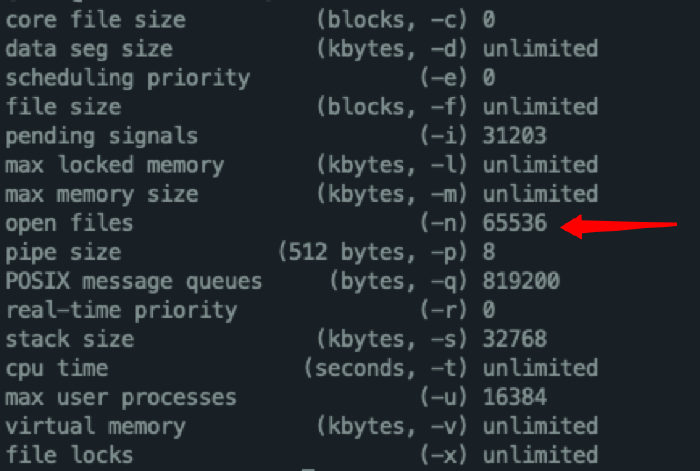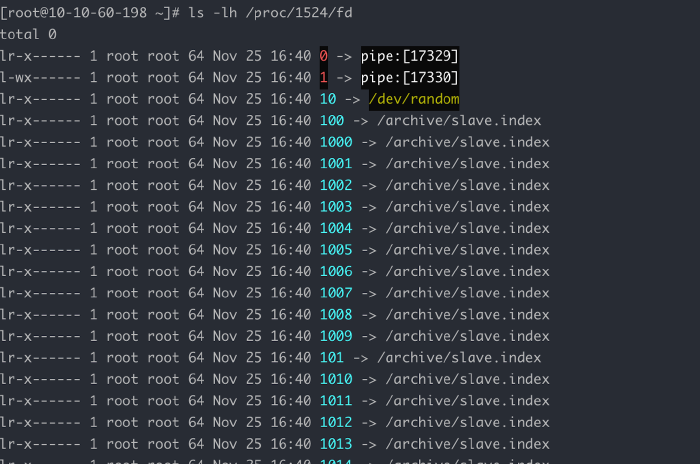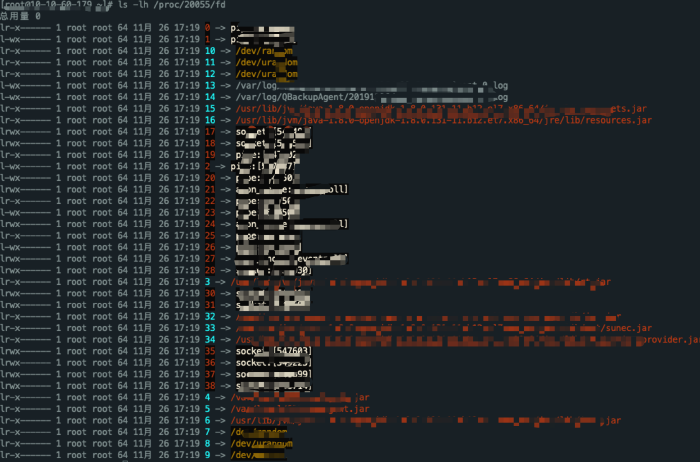Java 8 IO 流 陷阱
Last updated: Oct 219, 21029
问
今天下午,测试人员在测试 MySQL 备库修改存储配置时,必现如下错误:
description: “CONSUME_MSG_FAIL”
details: “CloudRuntimeException(id=44d32759dcd54f1db2bec0d748864274, message=Shell command failed:↵xfs_growfs /data, causeOfStr=java.io.IOException:
Cannot run program “/bin/bash” (in directory “/root”): error=24, Too many open files)”
最后一行报错信息是 Too many open files
答
原因
Too many open files
不同说法:
句柄数超出系统限制
程序打开的文件/socket连接数量超过系统设定值
进程在某个时刻打开了超过系统限制的文件数量以及通讯链接数
解决
ulimit -a

其中 open files (-n) 65536 表示允许单个进程最大允许打开的文件数量是 65536
ps axu | grep java

lsof -p ${PID} | wc -l

小结
从前三个步骤看出,4196 << 65536,因此不需要增大进程可以打开的文件数
同时需要进一步查看 4196 个句柄的持有者是谁?
ls -lh /proc/${PID}/fd

发现 slave.index 的句柄泄漏了,需要定位到代码中
定位
原先代码
private List<String> getAllBinLogs(Comparator<String> comparator) {
...
String content = readFile(binLogIndexPath);
return ...;
}
private String readFile(String filePath) {
Path path = Paths.get(filePath);
String content = null;
try {
content = Files.lines(path).collect(Collectors.joining());
} catch (IOException e) {
e.printStackTrace();
}
return content;
}
追溯到 Files.lines(Path path) 的源码可以看到:
public static Stream<String> lines(Path path, Charset cs) throws IOException {
BufferedReader br = Files.newBufferedReader(path, cs);
try {
return br.lines().onClose(asUncheckedRunnable(br));
} catch (Error|RuntimeException e) {
try {
br.close();
} catch (IOException ex) {
try {
e.addSuppressed(ex);
} catch (Throwable ignore) {}
}
throw e;
}
}
现在关注该方法上的两段注释:
Read all lines from a file as a {@code Stream}. Unlike {@link readAllLines(Path, Charset) readAllLines}, this method does not read all lines into a {@code List}, but instead populates lazily as the stream is consumed.
The returned stream encapsulates a {@link Reader}. If timely disposal of file system resources is required, the try-with-resources construct should be used to ensure that the stream’s {@link Stream#close close} method is invoked after the stream operations are completed.
提到了 readAllLines(Path, Charset) 方法,看一下:
public static List<String> readAllLines(Path path, Charset cs) throws IOException{
try (BufferedReader reader = newBufferedReader(path, cs)) {
List<String> result = new ArrayList<>();
for (;;) {
String line = reader.readLine();
if (line == null)
break;
result.add(line);
}
return result;
}
}
可以看到,该方法清晰地使用了 try-with-resources 语法糖,保证文件的关闭
与此相反,Files.lines(Path path) 并没有保证文件的关闭
修复代码
private List<String> getAllBinLogs(Comparator<String> comparator) {
...
List<String> content;
try {
content = Files.readAllLines(Paths.get(binLogIndexPath));
} catch (IOException e) {
throw new CloudRuntimeException(e);
}
return ...;
}
验证

没有泄漏的句柄,Over
